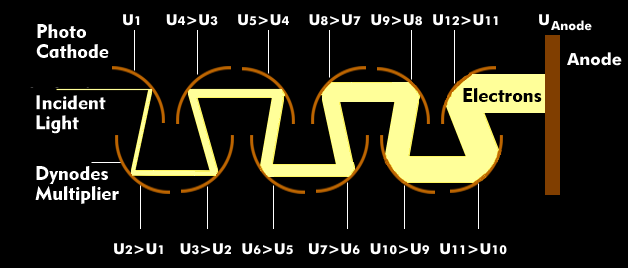electron multiplier tube (EMT)
Secondary electron multipliers (SEV) exploited the effect that certain materials emit secondary electrons when struck by electrons. Depending on the material, the accelerating voltage and the angle of entry of the electrons into the electrode material, the number of escaping secondary electrons exceeds the number of impacting electrons by a multiple. This is related to the number of free and light-bonded electrons and to the penetration depth of the electrons.
Corresponding multiplier electrodes are called dynodes and have multiplication factors between 3 and 10, meaning that an impacting electron emits between three and ten secondary electrons.
Secondary electron multipliers consist of several dynodes arranged in series, each connected to an accelerating voltage. The individual accelerating voltages have increasing potential and generate electrostatic fields between the dynodes with which the secondary electrons are accelerated from one dynode to the other.
The multiplication effect of the secondary electrons cumulates from dynode to dynode. For example, if the multiplication factor per dynode is two, then at 10 dynodes (`2^10`) the multiplication is a thousandfold, and at a factor of four (`4^10`) it is already a millionfold.
Secondary electron multipliers (SEV) are constructed as electron tubes, they are low- noise and are used in photomultipliers, image intensifiers, electron and mass spectrometers.

